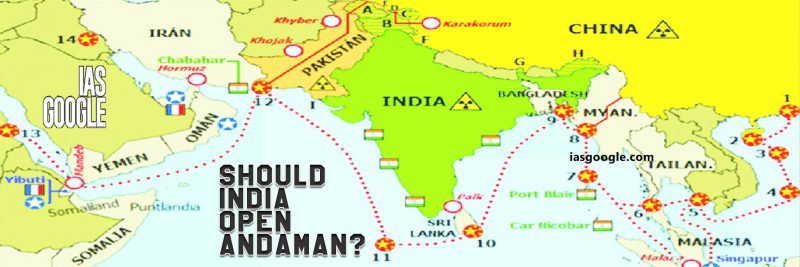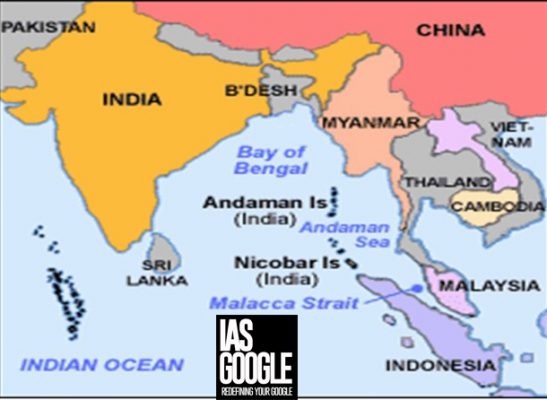- Home
- Prelims
- Mains
- Current Affairs
- Study Materials
- Test Series
 EDITORIALS & ARTICLES
EDITORIALS & ARTICLES
Should Andaman be opened to US, Japan to track Chinese submarine in IOR?.
The clash in Galwan between the Indian and Chinese armies and the subsequent military build-up by both sides has triggered the worst bout of tension between the two countries in decades. Interestingly, one domain of competition between India and China has seemingly been ignored in the din over the Galwan debate: The maritime arena. This is perplexing as China's People's Liberation Army Navy (PLAN) has mounted a massive modernisation and shipbuilding programme in the past two decades and also increased forays into the Indian Ocean region.
 In recent years, the Government of India (GOI) has adopted a proactive policy aimed at transforming the Andaman and Nicobar Islands (A&N Islands), a tri-services command, as an economic hub and one of the key centres of India’s defence and security strategy.
Significance of A & N Islands
In recent years, the Government of India (GOI) has adopted a proactive policy aimed at transforming the Andaman and Nicobar Islands (A&N Islands), a tri-services command, as an economic hub and one of the key centres of India’s defence and security strategy.
Significance of A & N Islands

 A&N islands should not be opened, because
A&N islands should not be opened, because
 In recent years, the Government of India (GOI) has adopted a proactive policy aimed at transforming the Andaman and Nicobar Islands (A&N Islands), a tri-services command, as an economic hub and one of the key centres of India’s defence and security strategy.
Significance of A & N Islands
In recent years, the Government of India (GOI) has adopted a proactive policy aimed at transforming the Andaman and Nicobar Islands (A&N Islands), a tri-services command, as an economic hub and one of the key centres of India’s defence and security strategy.
Significance of A & N Islands
- Strategically located, the A&N Islands, larger than several island countries in themselves, are an asset in India’s defence and strategic calculus.
- The Islands straddle Duncan’s Passage and the Ten Degree Channel. The Preparis Channel and Six Degree Channel are located to the north and south of the Island chain, respectively. All these passages are important trade routes for any shipping destined for Southeast and East Asia.
- The 572 islands, out of which only 38 are inhabited, comprise 30 per cent of India’s Exclusive Economic Zone (EEZ). The Six Degree and Ten Degree Channels in the Andaman Sea which lead to the Malacca Strait are vital to the sea lanes of communication (SLOCs) along which flows global commerce, including energy trade, between Asia, Africa and the Pacific.
- The A&N Islands are at the intersection of the Indian Ocean and the South China Sea, and further to the Pacific Ocean, an important fulcrum of the strategic concept of the Indo-Pacific.

 A&N islands should not be opened, because
A&N islands should not be opened, because
- If naval vessels and military aircraft of other major navies become regular visitors to the A&N Islands it could accentuate China’s ‘Malacca Dilemma’. Given the complexity of India-China bilateral relations, these strategic interactions at the A&N Islands may rile China and lead to further antagonism between the two countries.
- Enhancing interaction through visits by warships and military aircraft could be a ‘slippery slope’ which could progressively lead to more complex demands for strategic collaboration through the joint deployment of naval and military assets for other contingencies beyond the scope of India’s direct strategic interests.
- India may be seen as part of a collaborative framework against China in which other countries are already in a declared military alliance, for example, US-Australia, US-Japan, etc.
- In case India takes a liberal approach towards visits by other major powers, there should be a substantive quid pro quo particularly in relation to the US and Australia.
- The Malacca Strait is an international waterway. Hundreds of nations ply their naval and merchant ships through those waters, including Japan, the Republic of Korea (ROK) and others. It is not used exclusively by China, nor does China have a lien on defining its strategic importance. Simply because it is a potential choke-point does not mean that there is any intention on the part of India or any foreign naval vessel that India permits to visit the A&N Islands, to threaten China’s trade and energy flows through that waterway. In any case, foreign navies are regularly traversing the Malacca Strait and the international waters off the A&N Islands.
- On its part, China does not show any concern for India’s sensitivities in its deployments in the Indian Ocean, not even when visiting its immediate vicinity. This is not analogous to foreign navies being permitted by India, on a case-by-case basis, to access the A&N Islands. Such action is not taking place in China’s immediate vicinity. India needs to delink visits by friendly navies to the A&N Islands from the so-called China factor (China’s “Malacca Dilemma”).
- Allowing foreign naval vessels to visit the A&N Islands on a case-by-case basis does not tantamount to a “slippery slope”. It is entirely up to India to assess any future requests by foreign navies and decide whether to accede to requests for a strategic collaboration – including proposals for joint exercises – on a case-by-case basis. India retains the right to decline any activity that goes beyond its strategic interests or areas of operation.
- Ship visits are a normal and natural part of naval cooperation between friendly nations. This has no bearing on whether the visiting naval power has a defence partnership or alliance with third countries. China has held joint exercises with Pakistan in the Indian Ocean, and recently with Iran and Russia in the Persian Gulf and also with South Africa and Russia in the western Indian Ocean. India’s concerns have not been a factor for China.
- If India allows the US Navy or any other navy to visit the A&N Islands, indeed, there should be a well-considered quid pro quo.
- India can seek a quid pro quo in return advanced ‘military technological transfer’ and transfer of sophisticated weapons which the US may now, under the current geostrategic situation in the Indo-Pacific, be willing to provide to India.
- Access to the US assets to carry out operational turnaround (OTR) at the A&N Islands is in accordance with the Logistics Exchange Memorandum of Agreement (LEMOA), which is a bilateral matter that brooks no third-party interference or consideration.
- In so far as Australia is concerned, the strategic relevance of reciprocal access to the A&N Islands and the Keeling (Cocos) Islands needs to be mutually appreciated along with the significance of Darwin, on the northern seaboard of Australia overlooking the Lombok and Sunda Straits. While there exists a robust MDA information-sharing agreement between India and Australia, the two sides should consider expanding the scope of cooperation by formalising a protocol for ensuring an effective underwater surveillance system. This may include technical collaboration for a SOSUS chain around Sunda and Ombai Wetar Straits. For this, both India and Australia should engage Indonesia as a key participant.









 Latest News
Latest News General Studies
General Studies